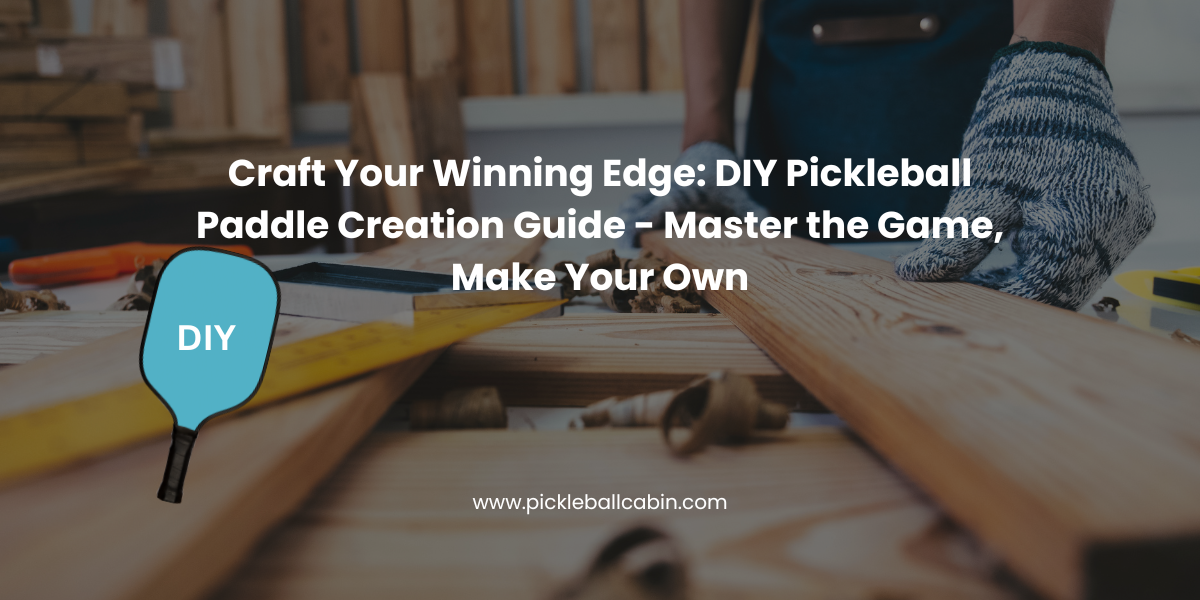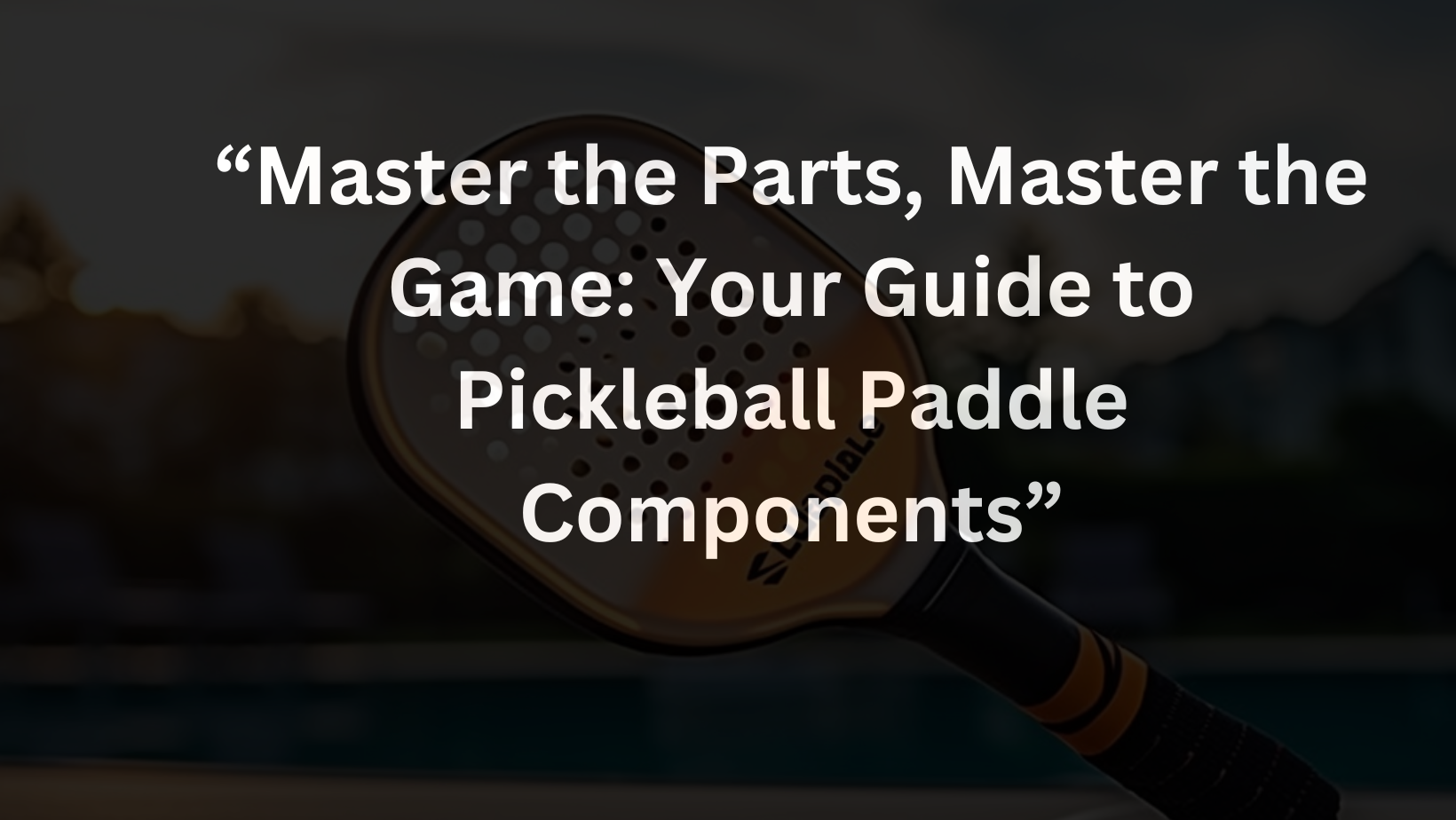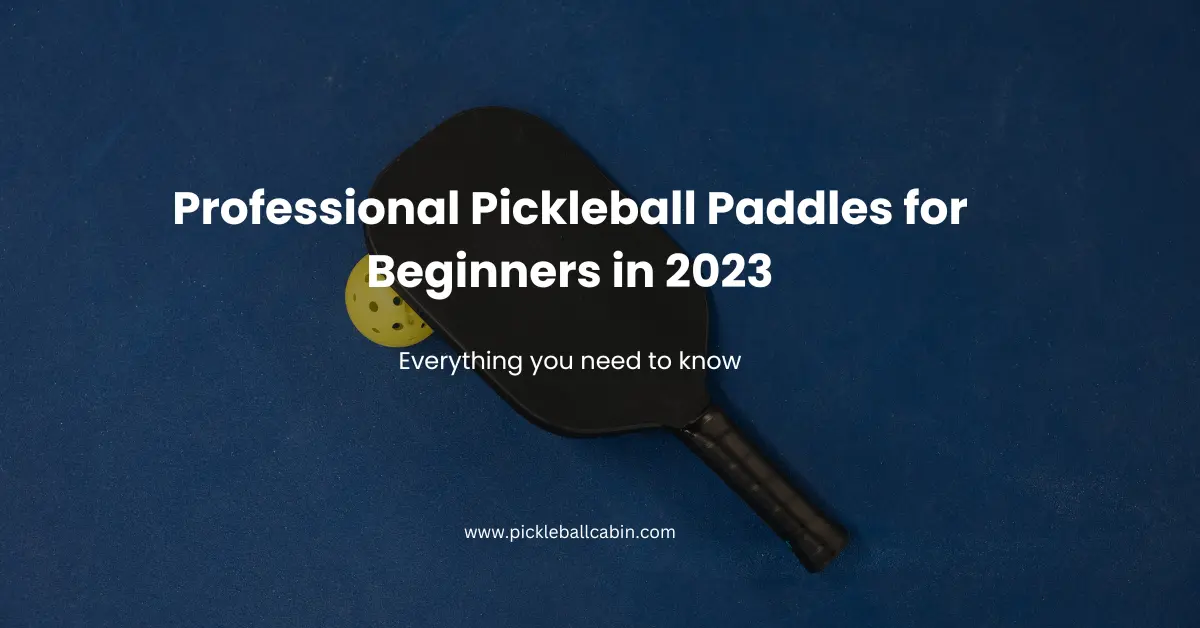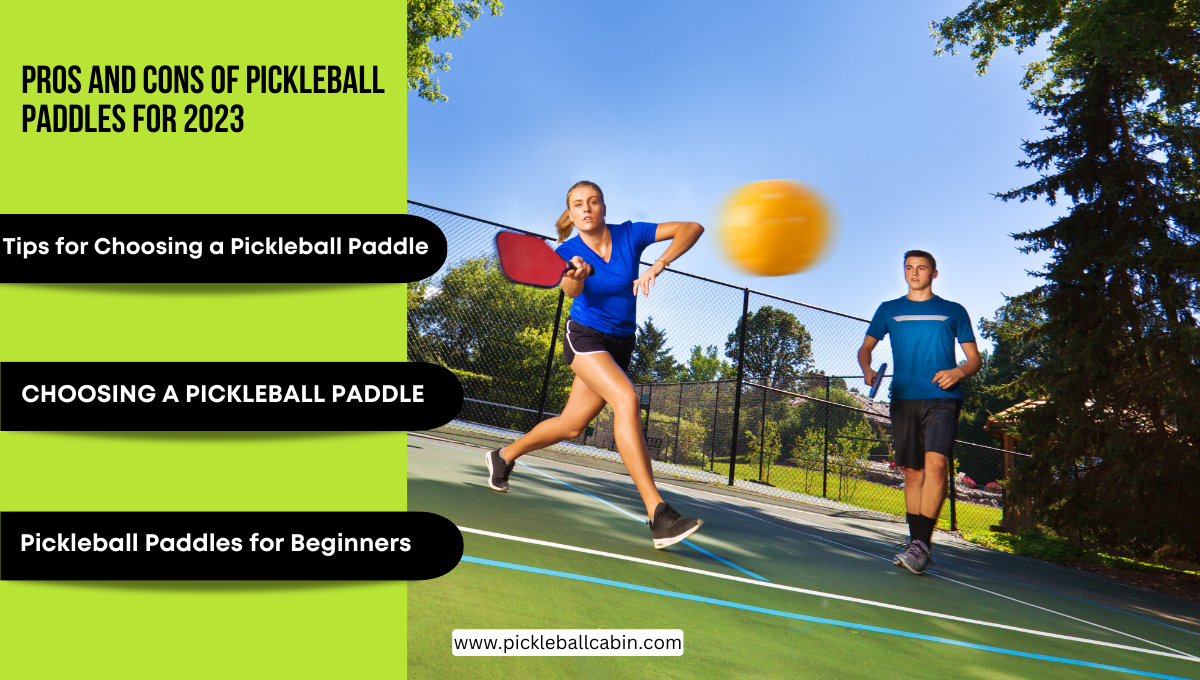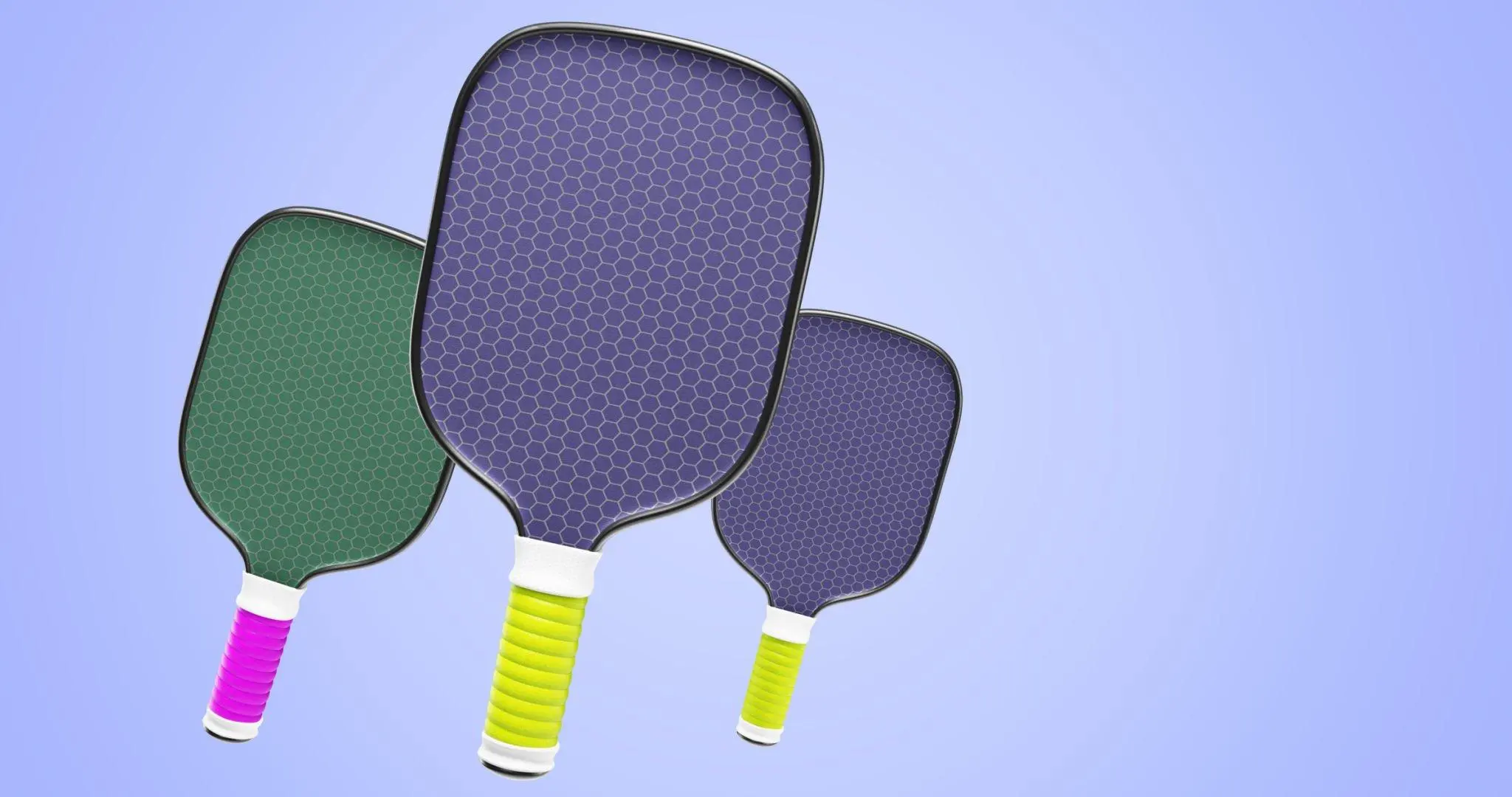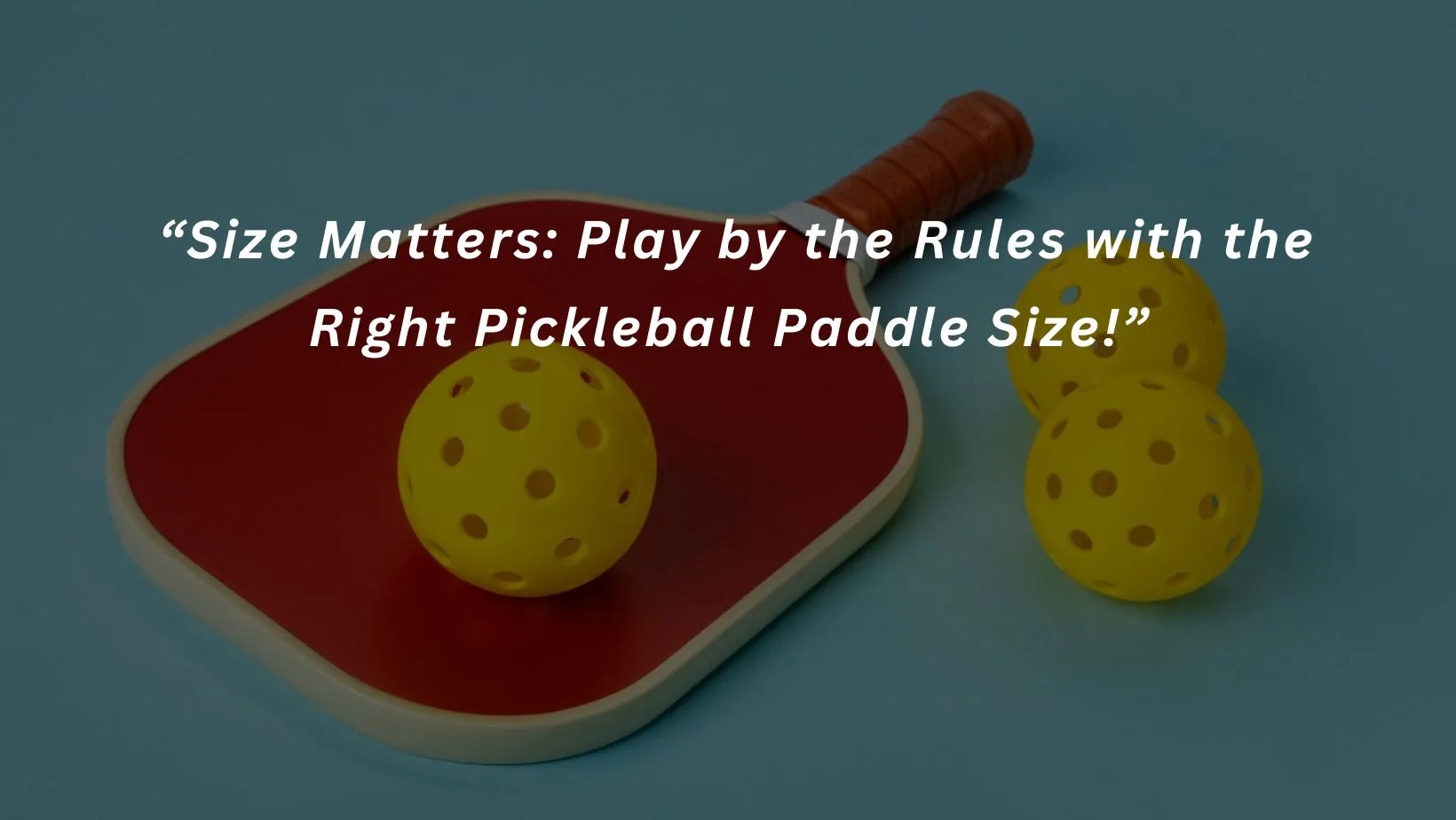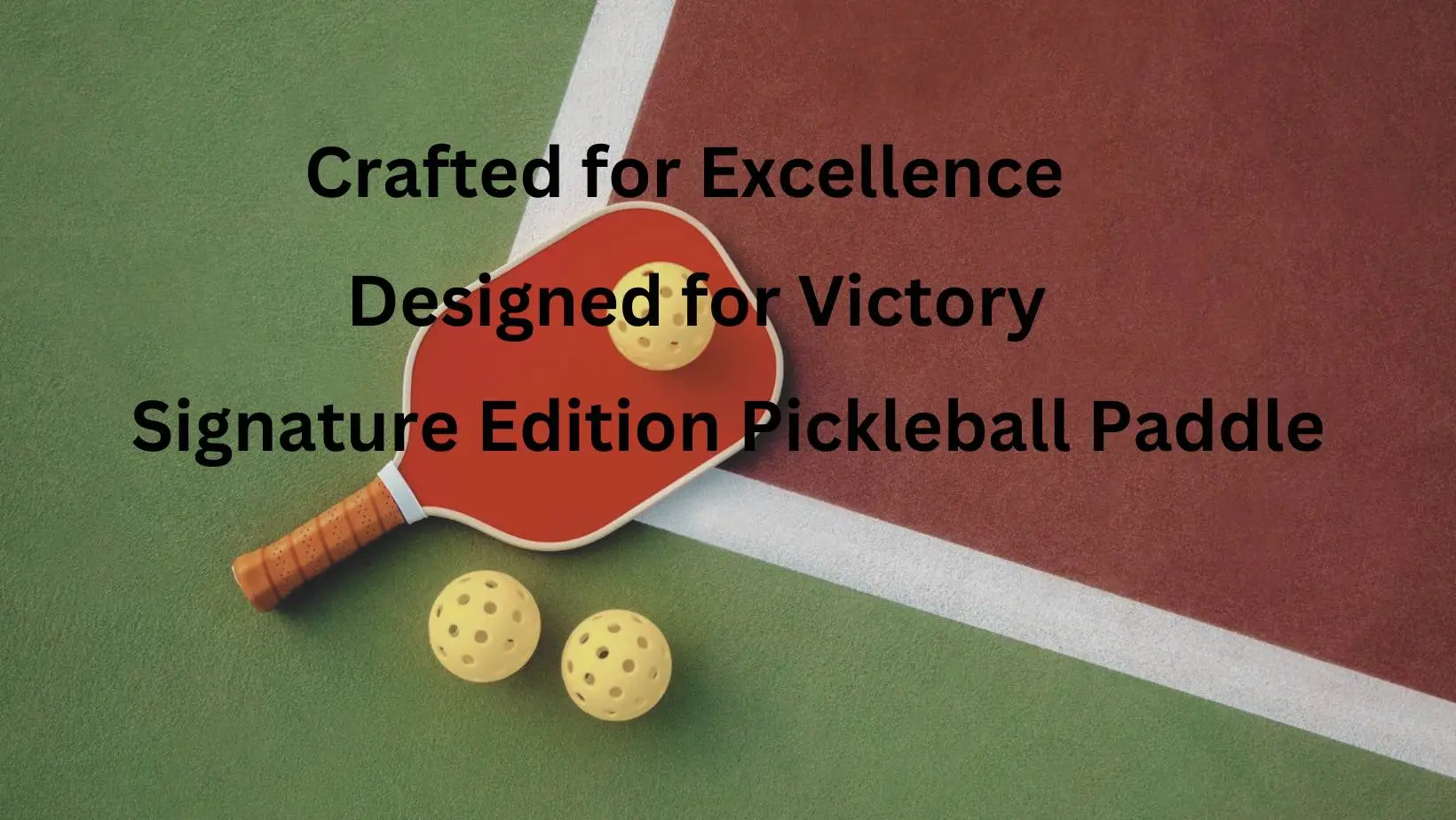DIY Pickleball Paddle
Are you a Pickleball player looking for a new and exciting DIY Pickleball Paddle project? If so, prepare to enter the fascinating world of custom Homemade pickleball paddle design!
But what if you want to play pickleball with a paddle that is customized to your liking? What if you want to create a paddle that reflects your personality, style, and preferences? What if you want to save some money and have a unique piece of equipment that no one else has?
If you answered yes to any of these questions, then you might be interested in making your own pickleball paddle. Yes, you read that right. You can make your own pickleball paddle from scratch, using some basic tools and materials that you can find at your local hardware store or online.
In this article, we will show you how to make your own pickleball paddle, step by step. We will also explain why you might want to choose the DIY approach, what materials you need, and how to budget for your project. By the end of this article, you will have a clear idea of how to craft your own pickleball paddle and enjoy the game with a personal touch.
You can read more in details about pickleball paddles :
Read Ultimate Guide before Buying 2023
Paddles in the Market: Material Matters
Before diving into crafting your own paddle, it’s essential to understand the significance of materials used in commercial paddles. Pickleball paddles are made of different types of materials, each with its own advantages and disadvantages. The most common materials are:
- Wood: Wood is the original material used for pickleball paddles. It is cheap, durable, and easy to work with. However, wood is also heavy, bulky, and prone to warping and cracking. Wood paddles are suitable for beginners or casual players who want a simple and affordable option.
- Composite: Composite paddles are made of a core material covered by a surface layer. The core material can be aluminum, polymer, or nomex, while the surface layer can be fiberglass, carbon fiber, or graphite. Composite paddles are lightweight, strong, and versatile. They offer a balance of power and control, and can be customized to suit different playing styles and preferences. Composite paddles are popular among intermediate and advanced players who want a high-quality paddle with good performance characteristics.
- Graphite: Graphite paddles are a type of composite paddle that use graphite as the surface layer. Graphite is a form of carbon that is very light, stiff, and responsive. Graphite paddles are the lightest and most expensive paddles on the market. They provide excellent touch, feel, and accuracy, and are ideal for players who have a soft game and rely on finesse and placement.
As you can see, the material of your paddle can affect its weight, durability, performance, and price. Depending on your skill level, playing style, and budget, you might prefer one material over another. However, if you want to have more control over the material, shape, size, and design of your paddle, you might want to consider making your own.
The Allure of DIY: Why Personalization Packs a Punch
Making your own pickleball paddle can be a rewarding and satisfying experience. Not only can you save some money and have fun, but you can also create a paddle that is tailored to your needs and preferences. Here are some of the benefits of making your own pickleball paddle:
- Personalization: You can design your paddle to fit your hand size, grip style, and playing style. You can choose the material, shape, size, weight, and color of your paddle. You can also add some decorative touches, such as stickers, paint, or engraving, to make your paddle stand out from the crowd. You can create a paddle that is truly your own and reflects your personality and style.
- Creativity: You can unleash your creativity and imagination when making your own paddle. You can experiment with different materials, techniques, and designs, and see what works best for you. You can also learn new skills and gain some knowledge about woodworking, engineering, and physics. You can have fun and challenge yourself with a DIY project that is both enjoyable and educational.
- Satisfaction: You can feel a sense of accomplishment and pride when you finish making your own paddle. You can admire your work and show it off to your friends and family. You can also enjoy playing pickleball with a paddle that you made with your own hands. You can feel more connected and engaged with the game and the paddle, and have a better playing experience.
Why Choose DIY for Pickleball?
As you can see, making your own pickleball paddle can offer many advantages and personal satisfaction. However, you might still wonder why you should choose DIY for pickleball, when there are so many commercial paddles available in the market. Here are some of the reasons why you might want to choose DIY for pickleball:
- Availability: You might not be able to find a commercial paddle that suits your needs and preferences. You might have a specific idea of what you want in a paddle, but you can’t find it in any store or online. You might also have some special requirements, such as a larger or smaller grip, a thicker or thinner core, or a different surface texture, that are not offered by any commercial paddle. In that case, making your own paddle can give you more control over the availability and quality of your paddle.
- Affordability: You might not be able to afford a commercial paddle that meets your expectations. You might have a limited budget, but you still want a high-quality paddle that performs well. You might also want to have more than one paddle, for different purposes or occasions, but you can’t afford to buy multiple paddles. In that case, making your own paddle can save you some money and give you more value for your money.
- Variety: You might want to have more variety and options in your paddle collection. You might want to try different materials, shapes, sizes, and weights, and see how they affect your game. You might also want to have different paddles for different weather conditions, court surfaces, or opponents. In that case, making your own paddle can give you more flexibility and diversity in your paddle choices.
Crafting 101: Designing Your Masterpiece
Now that you have decided to make your own pickleball paddle, you need to start designing your masterpiece. The first step is to decide what kind of paddle you want to make, and what materials you need to make it. Here are some of the factors you need to consider when designing your paddle:
Material
As we mentioned before, the material of your paddle can affect its weight, durability, performance, and price. You need to choose material that suits your skill level, playing style, and budget. You also need to choose material that is easy to work with and available in your area. Some of the common materials you can use to make your own paddle are:
- Wood: Wood is the cheapest and easiest material to use for making your own paddle. You can find wood at any hardware store or lumber yard, or you can even use some scrap wood from your home or garage. You can use any kind of wood, such as pine, maple, oak, or plywood, as long as it is sturdy and smooth. You can also use wood glue, nails, screws, or clamps to join the pieces of wood together. Wood paddles are heavy, but they can also be durable and powerful.
- Composite: Composite is the most popular and versatile material to use for making your own paddle. You can find composite materials online or at some specialty stores, such as sports equipment or hobby shops. You can use any kind of composite material, such as aluminum, polymer, or nomex, for the core, and fiberglass, carbon fiber, or graphite, for the surface. You can also use epoxy, resin, or adhesive to bond the layers of composite together. Composite paddles are lightweight, strong, and adaptable.
- Graphite: Graphite is the most expensive and advanced material to use for making your own paddle. You can find graphite materials online or at some specialty stores, such as sports equipment or hobby shops. You can use graphite for both the core and the surface of your paddle, or you can use a composite core and a graphite surface. You can also use epoxy, resin, or adhesive to bond the layers of graphite together. Graphite paddles are the lightest, stiffest, and most responsive paddles on the market.
Shape
The shape of your paddle can affect its size, balance, and performance. You need to choose a shape that fits your hand size, grip style, and playing style. You also need to choose a shape that is easy to cut and finish. Some of the common shapes you can use to make your own paddle are:
- Standard: The standard shape is the most common and simple shape to use for making your own paddle. It is a rectangular shape with rounded corners and a straight handle. It has a length of about 15.5 inches, a width of about 8 inches, and a handle length of about 5 inches. The standard shape is suitable for most players and playing styles, as it offers a good balance of power and control, and a large sweet spot.
- Widebody: The widebody shape is a variation of the standard shape, with a wider width and a shorter length. It has a length of about 15 inches, a width of about 8.5 inches, and a handle length of about 5 inches. The widebody shape is suitable for players who want more surface area and a larger sweet spot, as it offers more forgiveness and consistency.
- Oversized: The oversized shape is another variation of the standard shape, with a longer length and a wider width. It has a length of about 16 inches, a width of about 8.25 inches, and a handle length of about 4.75 inches. The oversized shape is suitable for players who want more reach and power, as it offers more leverage and momentum.
- Blade: The blade shape is a unique and unconventional shape to use for making your own paddle. It is a narrow and elongated shape with a tapered handle. It has a length of about 17 inches, a width of about 7 inches, and a handle length of about 5.25 inches. The blade shape is suitable for players who want more speed and spin, as it offers more aerodynamics and maneuverability.
Size
The size of your paddle can affect its weight, balance, and performance. You need to choose a size that fits your hand size, grip style, and playing style. You also need to choose a size that is within the official rules and regulations of pickleball. According to the USA Pickleball Association (USAPA), the governing body of pickleball, the maximum size of a paddle is 24 inches in total length, including the handle, and 8.5 inches in total width. The minimum size of a paddle is not specified, but it should be large enough to hit the ball effectively. You can use a ruler, a tape measure, or a template to measure and mark the size of your paddle.
Weight
The weight of your paddle can affect its balance, performance, and comfort. You need to choose a weight that suits your skill level, playing style, and physical condition. You also need to choose a weight that is comfortable and safe for your wrist, elbow, and shoulder. The weight of a paddle can range from 6 to 14 ounces, depending on the material, shape, and size of the paddle. Generally, lighter paddles are easier to swing and control, but they also require more effort and skill to generate power and speed. Heavier paddles are harder to swing and control, but they also provide more power and stability. You can use a scale, a balance, or a comparison to weigh your paddle.
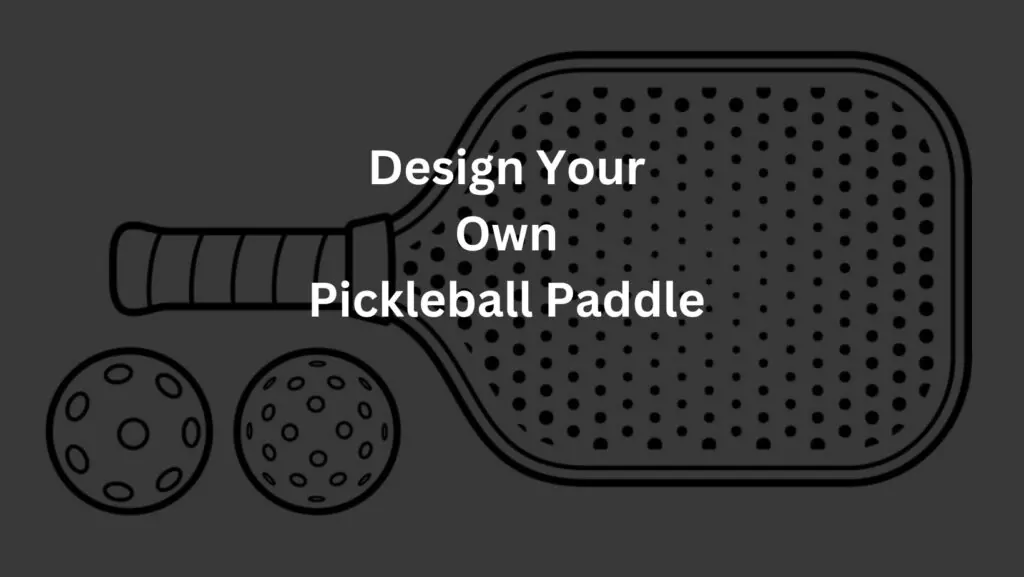
A Step-by-Step Guide to Crafting Your DIY Pickleball Paddle
Now that you have decided on the material, shape, size, and weight of your paddle, you are ready to start crafting your DIY pickleball paddle. Here is a step-by-step guide to help you create your very own pickleball paddle:
Step 1: Cut out the paddle
The first step is to cut out the paddle from the material you have chosen. You will need a cutting tool, such as a saw, a jigsaw, a router, or a CNC machine, to cut out the paddle. You will also need a template, a ruler, a pencil, and a clamp, to mark and secure the material. Here is how to cut out the paddle:
- Wood: If you are using wood, you will need a saw, such as a hand saw, a circular saw, or a table saw, to cut out the paddle. You will also need a template, such as cardboard, paper, or plastic, to trace the shape of the paddle on the wood. You can use a standard, a widebody, an oversized, or a blade template, depending on your preference. You can also create your own template, as long as it is within the official size limits. You can find some pickleball paddle templates online, or you can make your own using a ruler and a pencil. To cut out the paddle, follow these steps:
- Place the template on the wood and trace the outline of the paddle with a pencil. Make sure the template is aligned with the grain of the wood, and that the handle is at least 5 inches long.
- Clamp the wood to a stable surface, such as a workbench or a table, and make sure it is secure and flat.
- Use the saw to cut along the outline of the paddle, following the pencil marks. Be careful not to cut too close to the edge, as you will need some extra material for sanding and finishing. You can also use a drill to make holes for the corners, and then use the saw to connect the holes.
- Remove the clamps and the template, and check the paddle for any defects or irregularities. You can use a file, a rasp, or sandpaper, to smooth out any rough edges or corners.
- Composite: If you are using composite, you will need a jigsaw, a router, or a CNC machine, to cut out the paddle. You will also need a template, such as cardboard, paper, or plasticc, to trace the shape of the paddle on the composite. You can use a standard, a widebody, an oversized, or a blade template, depending on your preference. You can also create your own template, as long as it is within the official size limits. You can find some pickleball paddle templates online, or you can make your own using a ruler and a pencil. To cut out the paddle, follow these steps:
- Place the template on the composite and trace the outline of the paddle with a pencil. Make sure the template is aligned with the direction of the fibers, and that the handle is at least 5 inches long.
- Clamp the composite to a stable surface, such as a workbench or a table, and make sure it is secure and flat.
- Use the jigsaw, the router, or the CNC machine, to cut along the outline of the paddle, following the pencil marks. Be careful not to cut too close to the edge, as you will need some extra material for sanding and finishing. You can also use a drill to make holes for the corners, and then use the jigsaw, the router, or the CNC machine, to connect the holes.
- Remove the clamps and the template, and check the paddle for any defects or irregularities. You can use a file, a rasp, or a sandpaper, to smooth out any rough edges or corners.
- Graphite: If you are using graphite, you will need a CNC machine, to cut out the paddle. You will also need a template, such as a cardboard, a paper, or a plastic, to trace the shape of the paddle on the graphite. You can use a standard, a widebody, an oversized, or a blade template, depending on your preference. You can also create your own template, as long as it is within the official size limits. You can find some pickleball paddle templates online, or you can make your own using a ruler and a pencil. To cut out the paddle, follow these steps:
- Place the template on the graphite and trace the outline of the paddle with a pencil. Make sure the template is aligned with the direction of the fibers, and that the handle is at least 5 inches long.
- Clamp the graphite to a stable surface, such as a workbench or a table, and make sure it is secure and flat.
- Use the CNC machine to cut along the outline of the paddle, following the pencil marks. Be careful not to cut too close to the edge, as you will need some extra material for sanding and finishing. You can also use a drill to make holes for the corners, and then use the CNC machine to connect the holes.
- Remove the clamps and the template, and check the paddle for any defects or irregularities. You can use a file, a rasp, or sandpaper, to smooth out any rough edges or corners.
Step 2: Sand and finish the paddle
The second step is to sand and finish the paddle to make it smooth and safe. You will need a sanding tool, such as a sandpaper, a sanding block, or a sander, to sand the paddle. You will also need a finishing tool, such as a paint, a stain, a varnish, or a sealant, to finish the paddle. Here is how to sand and finish the paddle:
- Wood: If you are using wood, you will need a sandpaper, a sanding block, or a sander, to sand the paddle. You will also need a paint, a stain, a varnish, or a sealant, to finish the paddle. To sand and finish the paddle, follow these steps:
- Use a medium-grit sandpaper, such as 80 or 100 grit, to sand the paddle. Start with the edges and corners, and then move to the surface. Sand the paddle until it is smooth and even, and remove any splinters or rough spots. You can use a sanding block or a sander to make the process easier and faster.
- Use a finer-grit sandpaper, such as 150 or 180 grit, to sand the paddle again. This will make the paddle smoother and finer, and prepare it for the finishing. You can use a sanding block or a sander to make the process easier and faster.
- Use a paint, a stain, a varnish, or a sealant, to finish the paddle. You can choose any color or style you like, as long as it is compatible with wood. You can also use a stencil, a sticker, or a marker, to add some personal or decorative touches to your paddle. You can also use a clear coat, such as polyurethane or lacquer, to protect your paddle from moisture and damage. Follow the instructions on the product label, and apply the finishing evenly and smoothly. You can use a brush, a roller, or a spray to apply the finishing. Let the finishing dry completely before using your paddle.
- Composite: If you are using composite, you will need a sandpaper, a sanding block, or a sander, to sand the paddle. You will also needpaintt, a stain, a varnish, or a sealant, to finish the paddle. To sand and finish the paddle, follow these steps:
- Use a medium-grit sandpaper, such as 80 or 100 grit, to sand the paddle. Start with the edges and corners, and then move to the surface. Sand the paddle until it is smooth and even, and remove any bumps or scratches. You can use a sanding block or a sander to make the process easier and faster.
- Use a finer-grit sandpaper, such as 150 or 180 grit, to sand the paddle again. This will make the paddle smoother and finer, and prepare it for the finishing. You can use a sanding block or a sander to make the process easier and faster.
- Use a paint, a stain, a varnish, or a sealant, to finish the paddle. You can choose any color or style you like, as long as it is compatible with composite. You can also use a stencil, a sticker, or a marker, to add some personal or decorative touches to your paddle. You can also use a clear coat, such as a polyurethane or lacquer, to protect your paddle from moisture and damage. Follow the instructions on the product label, and apply the finishing evenly and smoothly. You can use a brush, a roller, or a spray, to apply the finishing. Let the finishing dry completely before using your paddle.
- Graphite: If you are using graphite, you will need a sandpaper, a sanding block, or a sander, to sand the paddle. You will also need a paint, a stain, a varnish, or a sealant, to finish the paddle. To sand and finish the paddle, follow these steps:
- Use a medium-grit sandpaper, such as 80 or 100 grit, to sand the paddle. Start with the edges and corners, and then move to the surface. Sand the paddle until it is smooth and even, and remove any bumps or scratches. You can use a sanding block or a sander to make the process easier and faster.
- Use a finer-grit sandpaper, such as 150 or 180 grit, to sand the paddle again. This will make the paddle smoother and finer, and prepare it for the finishing. You can use a sanding block or a sander to make the process easier and faster.
- Use a paint, a stain, a varnish, or a sealant, to finish the paddle. You can choose any color or style you like, as long as it is compatible with graphite. You can also use a stencil, a sticker, or a marker, to add some personal or decorative touches to your paddle. You can also use a clear coat, such as a polyurethane or a lacquer, to protect your paddle from moisture and damage. Follow the instructions on the product label, and apply the finishing evenly and smoothly. You can use a brush, a roller, or a spray, to apply the finishing. Let the finishing dry completely before using your paddle.
Step 3: Customize your paddle
The third step is to customize your paddle to make it more comfortable and functional. You will need a grip, an edge guard, and a paddle cover, to customize your paddle. Here is how to customize your paddle:
- Grip: The grip is the part of the paddle that you hold with your hand. It is important to have a grip that fits your hand size, grip style, and playing style. You can use a commercial grip, such as a tennis grip, a pickleball grip, or a wrap grip, to customize your paddle. You can also use a DIY grip, such as duct tape, an electrical tape, or a tennis tape, to customize your paddle. To customize your paddle with a grip, follow these steps:
- Measure your hand size and grip style, and choose a grip that matches your preferences. You can use a ruler, a tape measure, or a comparison, to measure your hand size and grip style. You can also use a chart, a guide, or a recommendation, to choose a grip that matches your preferences. You can find some pickleball grip charts, guides, and recommendations online, or you can ask an expert or a friend for advice.
- Remove the old grip from your paddle, if there is any. You can use scissors, a knife, or a peeler, to remove the old grip from your paddle. Be careful not to damage the handle or the paddle.
- Apply the new grip to your paddle, following the instructions on the product label or the package. You can use a scissors, a knife, or a cutter, to cut the grip to the right size and shape. You can also use glue, a tape, or a staple, to secure the grip to the handle. Make sure the grip is aligned, smooth, and tight, and that there are no gaps or overlaps.
- Check the grip for any defects or irregularities, and adjust it if necessary. You can use a file, a rasp, or sandpaper, to smooth out any rough edges or corners. You can also use a glue, a tape, or staples to fix any gaps or overlaps.
- Edge guard: The edge guard is the part of the paddle that protects the edge from damage and wear. It is important to have an edge guard that fits your paddle size, shape, and weight. You can use a commercial edge guard, such as a plastic, a rubber, or a metal, to customize your paddle. You can also use a DIY edge guard, such as a duct tape, an electrical tape, or a tennis tape, to customize your paddle. To customize your paddle with an edge guard, follow these steps:
- Measure your paddle size and shape, and choose an edge guard that matches your preferences. You can use a ruler, a tape measure, or a template, to measure your paddle size and shape. You can also use a chart, a guide, or a recommendation, to choose an edge guard that matches your preferences. You can find some pickleball edge guard charts, guides, and recommendations online, or you can ask an expert or a friend for advice.
- Remove the old edge guard from your paddle, if there is any. You can use a scissors, a knife, or a peeler, to remove the old edge guard from your paddle. Be careful not to damage the edge or the paddle.
- Apply the new edge guard to your paddle, following the instructions on the product label or the package. You can use a scissors, a knife, or a cutter, to cut the edge guard to the right size and shape. You can also use a glue, a tape, or a staple, to secure the edge guard to the edge. Make sure the edge guard is aligned, smooth, and tight, and that there are no gaps or overlaps.
- Check the edge guard for any defects or irregularities, and adjust it if necessary. You can use a file, a rasp, or sandpaper, to smooth out any rough edges or corners. You can also use a glue, a tape, or staples to fix any gaps or overlaps.
- Paddle cover: The paddle cover is the part of the paddle that protects the paddle from dust, moisture, and damage. It is important to have a paddle cover that fits your paddle size, shape, and weight. You can use a commercial paddle cover, such as a fabric, leather, or a vinyl, to customize your paddle. You can also use a DIY paddle cover, such as a cloth, a towel, or a bag, to customize your paddle. To customize your paddle with a paddle cover, follow these steps:
- Measure your paddle size and shape, and choose a paddle cover that matches your preferences. You can use a ruler, a tape measure, or a template, to measure your paddle size and shape. You can also use a chart, a guide, or a recommendation, to choose a paddle cover that matches your preferences. You can find some pickleball paddle cover charts, guides, and recommendations online, or you can ask an expert or a friend for advice.
- Remove the old paddle cover from your paddle, if there is any. You can use a scissors, a knife, or a peeler, to remove the old paddle cover from your paddle. Be careful not to damage the paddle or the paddle cover.
- Apply the new paddle cover to your paddle, following the instructions on the product label or the package. You can use scissors, a knife, or a cutter, to cut the paddle cover to the right size and shape. You can also use glue, a tape, or a staple, to secure the paddle cover to the paddle. Make sure the paddle cover is aligned, smooth, and tight, and that there are no gaps or overlaps.
- Check the paddle cover for any defects or irregularities, and adjust it if necessary. You can use a file, a rasp, or sandpaper, to smooth out any rough edges or corners. You can also use glue, tape, or a staple to fix any gaps or overlaps.
Step 4: Create the handle
The fourth step is to create the handle for your paddle. The handle is the part of the paddle that connects the paddle to the grip. It is important to have a handle that fits your hand size, grip style, and playing style. You can use a commercial handle, such as wood, a composite, or a graphite, to customize your paddle. You can also use a DIY handle, such as a dowel, a rod, or a pipe, to customize your paddle. To create the handle for your paddle, follow these steps:
- Measure your hand size and grip style, and choose a handle that matches your preferences. You can use a ruler, a tape measure, or a comparison, to measure your hand size and grip style. You can also use a chart, a guide, or a recommendation, to choose a handle that matches your preferences. You can find some pickleball handle charts, guides, and recommendations online, or you can ask an expert or a friend for advice.
- Cut the handle from the material you have chosen. You will need a cutting tool, such as a saw, a jigsaw, a router, or a CNC machine, to cut the handle. You will also need a template, a ruler, a pencil, and a clamp, to mark and secure the material. You can use a standard, a widebody, an oversized, or a blade template, depending on your preference. You can also create your own template, as long as it is within the official size limits. You can find some pickleball handle templates online, or you can make your own using a ruler and a pencil. To cut the handle, follow these steps:
- Place the template on the material and trace the outline of the handle with a pencil. Make sure the template is aligned with the direction of the fibers, and that the handle is at least 5 inches long.
- Clamp the material to a stable surface, such as a workbench or a table, and make sure it is secure and flat.
- Use the cutting tool to cut along the outline of the handle, following the pencil marks. Be careful not to cut too close to the edge, as you will need some extra material for sanding and finishing. You can also use a drill to make holes for the corners, and then use the cutting tool to connect the holes.
- Remove the clamps and the template, and check the handle for any defects or irregularities. You can use a file, a rasp, or a sandpaper, to smooth out any rough edges or corners.
- Attach the handle to the paddle. You will need a joining tool, such as a glue, a nail, a screw, or a clamp, to attach the handle to the paddle. You will also need a ruler, a pencil, and a level, to mark and align the handle to the paddle. To attach the handle to the paddle, follow these steps:
- Mark the center of the paddle and the center of the handle with a pencil. You can use a ruler, a tape measure, or a template, to mark the center of the paddle and the handle. You can also use a chart, a guide, or a recommendation, to mark the center of the paddle and the handle. You can find some pickleball center charts, guides, and recommendations online, or you can ask an expert or a friend for advice.
- Align the handle to the paddle, making sure the centers are matched and the handle is perpendicular to the paddle. You can use a level, a square, or a protractor, to align the handle to the paddle. You can also use a chart, a guide, or a recommendation, to align the handle to the paddle. You can find some pickleball alignment charts, guides, and recommendations online, or you can ask an expert or a friend for advice.
- Use the joining tool to attach the handle to the paddle, following the instructions on the product label or the package. You can use a glue, a nail, a screw, or a clamp, to attach the handle to the paddle. Make sure the joining tool is compatible with the material of the paddle and the handle, and that the handle is secure and stable. You can also use a drill, a hammer, or a screwdriver, to apply the joining tool to the handle and the paddle. Let the joining tool dry or set completely before using your paddle.
- Check the handle for any defects or irregularities, and adjust it if necessary. You can use a file, a rasp, or a sandpaper, to smooth out any rough edges or corners. You can also use a glue, a nail, a screw, or a clamp, to fix any gaps or overlaps.
Step 5: Enjoy
The fifth and final step is to enjoy your DIY pickleball paddle. You have successfully created your own pickleball paddle from scratch, using some basic tools and materials. You have also customized your paddle to suit your needs and preferences. You have a unique and personal piece of equipment that no one else has. You are ready to hit the court and play pickleball with your DIY paddle.
To enjoy your DIY pickleball paddle, follow these steps:
- Test your paddle for its performance and comfort. You can use a ball, a net, a court, or a wall, to test your paddle. You can also use a partner, a friend, or an opponent, to test your paddle. You can try different strokes, shots, and strategies, to test your paddle. You can also try different weather conditions, court surfaces, and opponents, to test your paddle. You can find some pickleball testing tips, tricks, and techniques online, or you can ask an expert or a friend for advice.
- Adjust your paddle if necessary. You can use a sandpaper, a file, or a rasp, to adjust the weight, balance, or performance of your paddle. You can also use a paint, a stain, a varnish, or a sealant, to adjust the color, style, or design of your paddle. You can also use a grip, an edge guard, or a paddle cover, to adjust the comfort, function, or protection of your paddle. You can find some pickleball adjustment tips, tricks, and techniques online, or you can ask an expert or a friend for advice.
- Have fun and play pickleball with your paddle. You can use a ball, a net, a court, or a wall, to play pickleball with your paddle. You can also use a partner, a friend, or an opponent, to play pickleball with your paddle. You can play for fun, for practice, or for competition, with your paddle. You can also play for fitness, for socializing, or for learning, with your paddle. You can find some pickleball playing tips, tricks, and techniques online, or you can ask an expert or a friend for advice.
5 Benefits for Homemade Pickleball Paddles
I have created a table that summarizes the main benefits and differences of homemade pickleball paddles compared to commercial ones. Here is the table:
| Benefit | Homemade Paddle | Commercial Paddle |
|---|---|---|
| Cost | Low | High |
| Customization | High | Low |
| Durability | Depends on material and craftsmanship | Depends on material and quality |
| Performance | Depends on design and skill level | Depends on design and skill level |
| Style | Unique and personal | Standard and generic |
As you can see, homemade pickleball paddles have the advantage of being more economical and customizable than commercial ones. You can choose your own material, shape, size, weight, and design for your paddle. You can also express your personality and creativity through your paddle. However, homemade paddles may not be as durable or perform as well as commercial ones, depending on the quality of the material and the craftsmanship. You also need to have some basic tools and skills to make your own paddle. Commercial paddles, on the other hand, offer more consistency and reliability in terms of durability and performance. They are also easier to buy and use, as you don’t need to spend time and effort making them. However, commercial paddles are more expensive and less customizable than homemade ones. You may not find a paddle that suits your preferences and needs perfectly. You also have less control over the style and appearance of your paddle.
On the Shelf Vs Custom Pickleball Paddle Comparison
I have created a table that compares the features and benefits of on the shelf pickleball paddles and custom pickleball paddles. Here is the table:
| Feature | On the Shelf Paddle | Custom Paddle |
|---|---|---|
| Cost | Varies depending on brand, quality, and material | Higher than on the shelf paddles, but more value for money |
| Customization | Limited to available options from manufacturers | Unlimited, you can choose your own material, shape, size, weight, design, and grip |
| Durability | Depends on material and quality, may degrade over time | Depends on material and craftsmanship, may last longer with proper care |
| Performance | Depends on design and skill level, may not suit your preferences and needs | Depends on design and skill level, but more likely to suit your preferences and needs |
| Style | Standard and generic, may look similar to other players’ paddles | Unique and personal, you can express your personality and creativity through your paddle |
As you can see, custom pickleball paddles have the advantage of being more customizable and personalized than on the shelf paddles. You can create your own paddle that fits your style and needs perfectly. However, custom paddles are more expensive and require more time and effort to make. You also need to have some basic tools and skills to make your own paddle. On the shelf paddles, on the other hand, offer more convenience and affordability than custom paddles. You can buy and use them easily, without spending too much time and money. However, on the shelf paddles are less customizable and personalized than custom paddles. You may not find a paddle that matches your style and needs exactly. You also have less control over the quality and durability of your paddle.
Budgeting and Pickleball: Striking the Balance
Making your own pickleball paddle can be a rewarding and satisfying experience, but it can also be a costly and time-consuming one. You need to balance your budget and your time, while crafting a high-quality DIY pickleball paddle. Here are some tips to help you strike the balance between budgeting and pickleball:
- Plan ahead: Before you start making your own paddle, you need to plan ahead and set a budget and a timeline for your project. You need to decide what kind of paddle you want to make, what materials you need to make it, and how much money and time you are willing to spend on it. You can use a spreadsheet, a calculator, or a planner, to plan ahead and set a budget and a timeline for your project. You can also use a chart, a guide, or a recommendation, to plan ahead and set a budget and a timeline for your project. You can find some pickleball planning charts, guides, and recommendations online, or you can ask an expert or a friend for advice.
- Shop around: Once you have planned ahead and set a budget and a timeline for your project, you need to shop around and find the best deals and offers for your materials and tools. You need to compare the prices, quality, and availability of different sources and suppliers, and choose the ones that suit your needs and preferences. You can use a website, an app, or a catalog, to shop around and find the best deals and offers for your materials and tools. You can also use a chart, a guide, or a recommendation, to shop around and find the best deals and offers for your materials and tools. You can find some pickleball shopping charts, guides, and recommendations online, or you can ask an expert or a friend for advice.
- Reuse and recycle: Another way to save money and time on your project is to reuse and recycle some of the materials and tools that you already have or can find easily. You can use some scrap wood, composite, or graphite, that you have left over from previous projects or can get from your home or garage. You can also use some old paddles, grips, edge guards, or paddle covers, that you have lying around or can get from your friends or family. You can also use some common household items, such as duct tape, electrical tape, or tennis tape, to customize your paddle. You can find some pickleball reuse and recycle tips, tricks, and techniques online, or you can ask an expert or a friend for advice.
How to Make a DIY Pickleball Paddle
Making your own pickleball paddle can be a fun and rewarding project, but it can also be a challenging and complex one. You need to follow some steps and guidelines, while crafting a high-quality DIY pickleball paddle. Here is a summary of the steps and guidelines to make your own pickleball paddle:
- Step 1: Cut out the paddle from the material you have chosen, using a cutting tool and a template.
- Step 2: Sand and finish the paddle to make it smooth and safe, using a sanding tool and a finishing tool.
- Step 3: Customize your paddle to make it more comfortable and functional, using a grip, an edge guard, and a paddle cover.
- Step 4: Create the handle for your paddle, using a handle material and a joining tool.
- Step 5: Enjoy your DIY pickleball paddle, testing, adjusting, and playing with it.
Remember:
With the right materials and shaping, you can customize a handmade wooden paddle to your preferred weight and play style. While not regulation for tournaments, a homemade paddle is great for recreational play and lets you add personal flair with stickers or designs.
By following these steps and guidelines, you can create your own pickleball paddle from scratch, using some basic tools and materials. You can also customize your paddle to suit your needs and preferences, and have a unique and personal piece of equipment that no one else has. You can have fun and challenge yourself with a DIY project that is both enjoyable and educational. You can also enjoy playing pickleball with a paddle that you made with your own hands, and feel more connected and engaged with the game and the paddle.
You can also Watch the DIY Pickleball Paddle video Below.
Conclusion
In conclusion, venturing into the world of custom pickleball paddle design offers Pickleball players a rewarding and exciting experience. Crafting your own paddle allows for personalization, ensuring it aligns perfectly with your playing style and preferences.
Not only does this DIY project deliver a sense of accomplishment, but it also saves money compared to buying a pre-made paddle. Embrace the journey of creating your unique pickleball paddle and enjoy the pride of wielding an instrument tailored to maximize your abilities on the court. With some simple tools and patience, you can DIY a wooden pickleball paddle on any budget.
So, are you ready to take on the challenge and stand out on the pickleball court with your one-of-a-kind creation? Unleash your creativity, and let the games begin! 🏓🎨 #HomemadePickleballPaddle #DIYPickleballPaddle
You may also Like;
How to Add Texture to Your Pickleball Paddle?
FAQ
Q: What materials do I need to make my own pickleball paddle?
A: To make your own pickleball paddle, you will need wood veneer or plywood sheet, a paddle template or existing paddle to trace, a jigsaw or handheld saw, sandpaper (medium and fine grit), varnish or sealant, a drill, paddle grip, epoxy or wood glue, and clamps.
Q: How do I create a template for my pickleball paddle?
A: To create a template for your pickleball paddle, you can either find an existing paddle to trace onto a sheet of wood veneer or plywood, or you can design your own shape. Ensure that the dimensions of your paddle adhere to the official pickleball paddle guidelines.
Q: Can a pickleball paddle have a rubber surface?
No, rubber surfaces are not allowed on pickleball paddles. Official pickleball rules only permit non-compressible materials like wood, graphite or composites on the paddle face. Rubber is considered a compressible material that can impart additional spin and power, so it has been banned from use in regulated pickleball tournaments and events. Paddle edges may have some rubber or vinyl guards, but the main hitting surface cannot contain rubber.
Q: What is the process for cutting the paddle shape?
A: Once you have your template, place it onto the wood veneer or plywood sheet and trace the outline. Using a jigsaw or a handheld saw, carefully cut along the traced lines to obtain a smooth and accurate paddle shape.
Q: Can I put stickers on my pickleball paddle?
Yes, you can put stickers on your pickleball paddle as long as they don’t interfere with play. Avoid placing stickers on the paddle hitting surface. Use smooth, durable vinyl stickers on the paddle edge or rear face instead. Replace any stickers that become damaged or start peeling to maintain a smooth surface. Some tournaments may prohibit stickers, so check rules if playing competitively.
You may also Found this helpful; Stylish Pickleball Paddle | Make You Look Good On The Court
Q: Can you make a pickleball paddle out of wood?
Yes, you can make a pickleball paddle out of wood. The most common woods used are maple, ash, poplar, and spruce. Shape the wood into an elongated oval about 15.5 inches long and 8 inches wide. Sand the paddle face smooth and thin to about 1/4 inch. Drill holes to adjust the weight if needed. Attach a grip tape and apply a protective sealant like polyurethane to finish. With the right wood and shaping, a handmade wooden paddle can play very well.
Read More at; Are wooden Pickleball Paddles Good?
Q: How do I add the grip to my pickleball paddle?
A: Start by marking the desired location for the grip on the handle of the paddle. Using a drill, create small holes along the marked area. Apply epoxy or wood glue to the handle of the paddle, then carefully slide the grip onto the handle, aligning the holes with the drilled holes. Secure the grip in place with screws or other fasteners and use clamps to hold it firmly while it dries.
Read More at; How To Grip Pickleball Paddle: Master Your Skills Today
